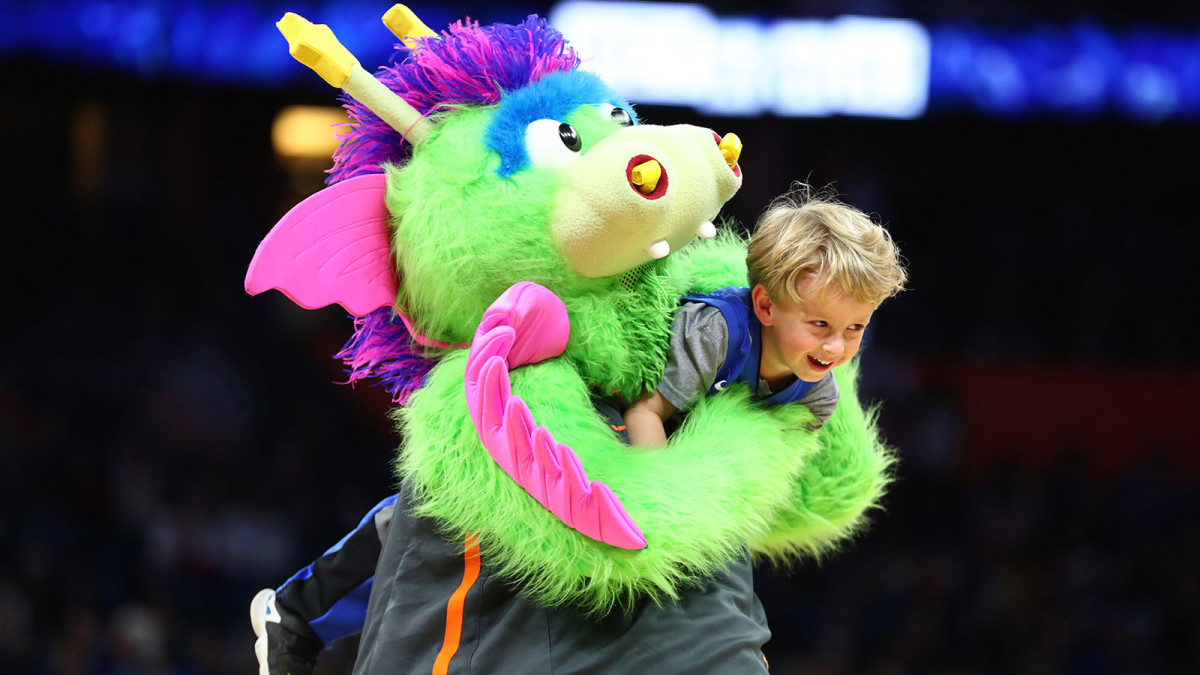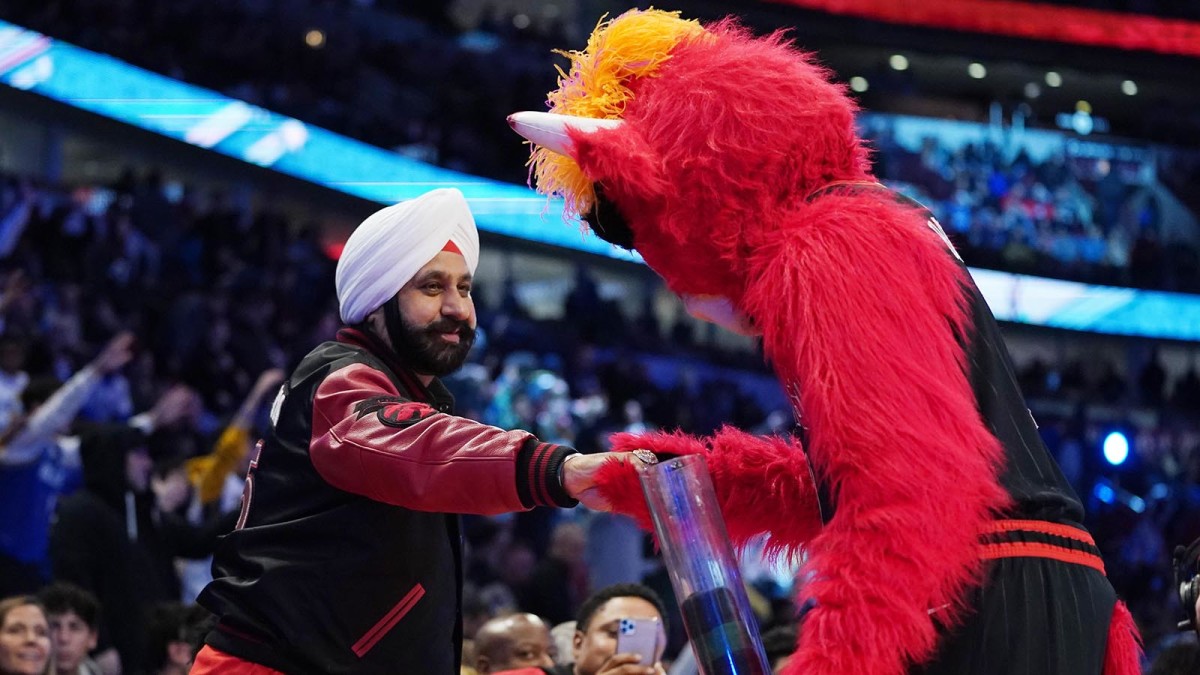When the Show Stops: How NBA Mascots Are Coping During the Coronavirus Crisis
The Celtics’ Lucky the Leprechaun was excited to see everyone late last week when he signed on to a Zoom call with more than a dozen other NBA mascots. “Hey, what’s up, guys? What’s the plan? What are we talking about?” he asked.
The Mavericks’ Champ appeared to be in his kitchen, while Toronto’s The Raptor was sitting at the bottom of a stairwell, where the Wi-Fi was presumably strongest. Only this particular video chat was vastly different than the seemingly endless amount of professional video chats that took place in the recent days and weeks around the world. No one else spoke up, not even with a single hello.
“Are you guys all on mute? Guys, I can’t hear anything, what’s going on?” Lucky repeated, shortly before hanging up in frustration.
Amid the on-going global COVID-19 pandemic, the NBA mascot industry is relatively low on any hypothetical list of those most impacted. But purely in the sports and entertainment space, the NBA mascot is now left with a complicated conundrum. In a time of social distancing, with no crowds to charm, no community events to attend, what do you do now?
“I can’t imagine what those guys are going through,” says Kevin Vanderkolk, who performed as the Bucks’ Bango for 14 seasons before retiring in 2014.
NBA mascots are accustomed to enchanting and enthralling 18,000 fans on a given night. Their schedules are loaded, not just as a result of performing during games, but more so by all the other components that come with wearing the suit. The full-time job—and it is very much a full-time job—can also include 300 community appearances per year, potentially more. They have so many appearances that some mascots have assistants who help with administrative bookings. There are lengthy creative meetings behind the scenes and annual overseas trips, which bring industry veterans to places like China, France and Brazil.
There are also no offseasons.
In conversations with countless former and current NBA mascots—many of whom requested anonymity as a means to protect their human identities under the mask—the coronavirus is already having a palpable impact on the industry at-large.

All but four NBA teams have mascots, with the Lakers, Warriors, Knicks and Nets being the lone holdouts. And for those teams that do have them, the end of the regular season is normally full of celebrations. After all, the stretch run is birthday season.
Each NBA mascot designates a particular game as their birthday during a given regular season, creating events throughout the NBA calendar that bring together countless mascots from all over the league. They are not only enjoyable for fans in attendance, but also fun for those in the suit. They’re a way to “recharge,” says Rob Wicall, who retired in 2016 after almost two-decades as the Spurs’ Coyote. “It’s just fun to be around a lot of creative guys. You don’t get that a ton. It was a little bit of pick-me-up to go to those and see those guys that do what you do.”
But on the night of March 11, those future birthday plans, and many others plans, changed. Per a current mascot, many in the “fur-turnity,” as those in the mascot world call it, communicated via a group message as the league was put on hold. In the days that immediately followed, many were told to cancel events on their calendars, as like so many others around the world, and a period of uncertainty swept over the industry.
“It’s a tough pill to swallow,” one current mascot says. “There’s a jolt of happiness that you see when a mascot walks into a room, a love, an excitement, and those things are missing and it’s a shame. So we’re having to shift right now.”
Part of that shift involves the creative process. Stuck in isolation, many are using the hiatus to write new skits, come up with stunt ideas and learn additional skills. Per those still active, many mascots have been checking in with each other and exchanging ideas about what sketches may have worked or not worked earlier this season. “This time has enabled me to work on new exciting things our fans have never seen a mascot do before,” another current mascot adds.
There have been at-home Ping-Pong matches and push-up challenges. Plus, the aforementioned Zoom meeting.
New ideas might also involve summer themes, as it looks increasingly likely that the season will stretch beyond its usual mid-June end-date. Still, the possibility of a canceled season persists. It’s a disheartening thought for many, including the numerous mascots who have saved their premier material for the end of the season.
“99% of the people in this profession are obsessed with what they do,” a third active mascot says. “And this is like pulling teeth, like literally ripping your fingernails off. I’m saving all my best things to end with a bang. And now, who knows?”
Social distancing has made this current hiatus vastly different from other more recent league stoppages, namely those caused by NBA lockouts. While past NBA labor negotiations prevented players from interacting with team officials, mascots worked as they normally would have throughout those tense times.
“We were the only asset that the team had,” says Barry Anderson, who retired in 2016 from his decade-plus tenure as Chicago’s Benny the Bull.
Wicall adds that during those negotiations, “you were out in the community every day.” Now, mascots are stuck working out in the confines of their own residences, left not just without games, but also without communities to greet.
“I’m working on my honey-do list,” the Nuggets’ Rocky says through his handler. “And catching up on a lot of ‘Petflix.’”
Atlanta’s Harry the Hawk says through his handler that while he misses not being able to interact with the team’s fans, he’s enjoyed video chatting with his mascot friends and is “trying not to eat all of my birdseed at once.”
While multiple former mascots cite the human interactions as some of the more memorable parts of the job, there are also financial ramifications of all the missed appearances.
Unlike with the league’s players, there is no NBA mascot union and, in Anderson’s words, “you can get teams that are miles apart from each other in terms of contractual set-up.”
Those in the industry estimate that a top-tier mascot can potentially make around $200,000 a season, with the majority of NBA mascots more likely making between mid-to-upper five and lower six figures depending on their agreements. Many of those contracts are structured using a combination of annual salaries plus additional payouts per appearances, according to veterans of the profession. Those appearance dollars are absent as a result of the mass cancellations.

“It’s gonna change the dynamics of the industry," Wicall says of the pandemic’s impact. “But not just mascots, sports entertainment in general.”
International summer trips seem up in the air. This year’s annual NBA mascot conference was scheduled to be held in August in San Antonio. At the conference, mascots converse about everything from developing their characters and sharing ideas to discussing the business side of the industry, talking about contract structure and time management. “We take it very seriously,” Vanderkolk says. It too will likely be reworked in some way.
Before the league’s suspension of play, NBA teams had started preparing for games without fans. And for a profession that so often relies upon close, personal interactions, questions will likely remain about how much contact mascots can have with those in the crowds whenever gates next open.
“It’s in the back of my mind right now, if this goes into next season, all bets are off,” one of the aforementioned current mascots says. “Even if it does go into next season, are we going to have empty arenas? If we’re having empty arenas, what does that mean?
“There’s this huge cloud over our heads.”
But per multiple conversations with those in costumes, the uncertainty has not prevented them from developing ideas for social media and devising other ways to take fans’ minds off of the on-going health crisis.
The league’s mascots also know that in the future—whether it’s in the coming weeks or coming months—they will again take center stage of an NBA arena with the intention of wowing a crowd and bringing a stadium to life.
“If anybody can adapt, that’s what we’re meant to do," Wicall says. “That’s what we do on a daily basis. You’re in live entertainment, you have to adapt constantly. If anyone’s gonna figure it out, it’ll be these guys.”
